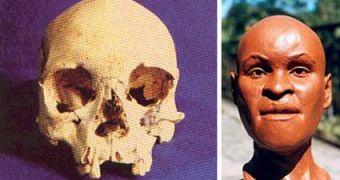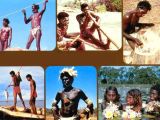It was long believed for a long time that the Amerindians met by the Europeans in the 15th century in the Americas were the first inhabitants of the New World and that 12,000 years ago, three waves of Proto-Mongoloid migratory people crossed the Behring area to the Americas.
But new and not so new discoveries revealed that the first inhabitants of America belonged to the Negroid type (Blacks).
Now, you do not have to think they were of the African type. They belonged to a racial group called Black Asians. This was the first human group to have moved out of Africa perhaps 60,000 years ago. The 40,000 years old European Cro-Magnon could have been of this type.
12,000 years ago, Black Asians were the main inhabitants of India, Indochina, Indonesia, New Guinea, Melanesia and perhaps even eastern China (or the whole eastern Asia).
One of the most primitive forms of this race is represented by the Australian Aborigines, who entered Australia about 40,000 years ago. A later type is that now constituted by the Papuans of New Guinea or Melanesians tribes in the western Pacific, who came there 21,000 years ago from Asia.
Unlike African Blacks, these people have abundant beards, a lot of hair on the body, are shorter, have slimmer lips, a tilted front (not cambered), prominent eye ridge and aquiline noses. The hair is somewhat less kinky.
A recent research made at Temple University revealed that this race is characterized by one of the highest genetic diversity amongst current human races (being bypassed just by the Bushmen, the oldest living human race), the mitochondrial DNA showing an age of at least 35,000 years for this human type.
But later than 12,000 years ago, in India white populations came from central and southwestern Asia, greatly displacing or mixing with this race. Even today, many Hindu populations, especially in the south, still preserve this Black Asian racial type and some Gurus from the south cannot be distinguished from Papuan or Australian Aborigines. In southeastern Asia, they were replaced by Mongoloids coming from Tibet, central China and Philippines.
The Black Asians were seen as one of the first colonizers of America after the analysis made on an 11,000-year skull dug in Brazil in 1974. The fossil was found 13 m (43 ft) deep in Lapa Vermelha IV, the region of Lagoa Santa (Minas Gerais), but only in 1995 was put under investigation, due to the long and false concept that humans entered Americas 40,000 years ago.
When researchers, using forensic methods, rebuilt the face of this ancient American woman, they remained petrified: the thick lips and flattened nose pointed without any doubt to the Negroid origin. Nothing to do with the Native Indians of the Americas. The fossil woman was baptized Luzia, recalling the famous 3.2 million years old Australopithecus female called Lucy. Luzia was 20-25 years old and 1.5 m (5 ft) tall, seemed to have belonged to a group of hunters-gatherers and could have been killed by a wild beast.
Further analysis of 15 fossil skulls discovered in Brazil, Colombia and Tierra del Fuego (Land of Fire), dated 11,500 to 8,500 years ago, but also other recent archaeological discoveries have confirmed the hypothesis that, before the Proto-Mongoloid (Proto-Asian) stock, a previous migratory human wave reached Americas more than 12,000 years ago.
These people were very similar to the Australian Aborigines, being characterized by a narrow and long skull, long face and small nose and eye sockets.
About 9,000 years ago they were followed by a second migratory wave from Siberia, of Proto-Mongoloid race (Proto-Mongoloid race means a more basic type of Mongoloid race, without well-defined traits characterizing the proper Mongoloids, like the Chinese or Japanese). These are the ancestors of the American Indians.
The later migrations occurred in the northern part of North America: two waves of Mongoloid people, the Eskimals.
But what happened with the ancient American Aborigines? They could have mixed with the waves of the newly arrived Indians. Indeed, in some remote tribes in South America, there can be seen really dark people (not so typical for Indians), with some beard and harsher traits.
Others believe the American Aborigines were wiped out by the ancient Indians. Scientists have found in Santana do Riacho (next to Lapa Vermelha) an 8 to 10,000 years old graveyard and splendid wall paintings, very similar to those made by the Australian Aborigines (further confirming the theory of the Black Asian colonization of the Americas).
Some painting attracted the attention of the researchers, as they depict one group of people attacking and killing another. The victims are represented as being darker skinned than the aggressors...
In the southern regions of South America, the relict tribes of the Alacalufs and a few others could have been if not the last remains of the American Negroids, at least a mixed type. But now these tribes are gone... DNA analysis on their descendants could find some clues.

 14 DAY TRIAL //
14 DAY TRIAL // 
